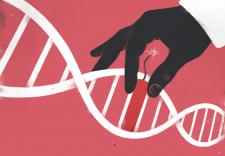Aggregated News

Two years ago, I was working on my laptop in an airport lounge in Newark, New Jersey, when I glanced up and saw a couple walking with their two boys. The younger boy slowly made his way on crutches, displaying the telltale signs of a hereditary disease called muscular dystrophy. Generally manifesting in childhood, the disease steadily robs those who have it of their ability to walk. Eventually, I knew, the crutches would no longer be enough.
My heart skipped a beat. Most types of muscular dystrophy originate with genetic mutations that weaken key muscle proteins, and I had just come from a meeting where a cure appeared possible, using CRISPR technology to rewrite the DNA of kids just like him.
Imagining how the technology I’d helped create could change this boy’s life, I was overwhelmed with emotion. Beyond hope and wonder, I was filled with a sense of fierce urgency to expand CRISPR’s impact to the people around the world who need it most.
Biotechnology as we know it today came of age in the 1970s, when the advent...



